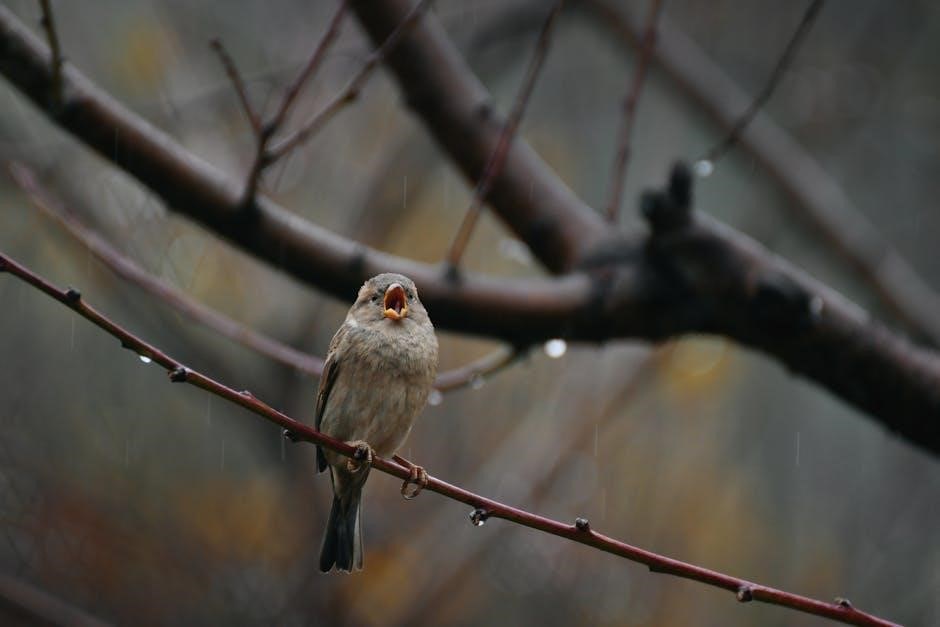The Rain Bird ESP Modular Controller offers a flexible, modular design, allowing easy expansion and customization for various irrigation needs. Its user-friendly interface and advanced features like Wi-Fi connectivity make it ideal for modern lawn care, ensuring efficient and tailored watering solutions.
Overview of the Rain Bird ESP Modular Controller
The Rain Bird ESP Modular Controller is a versatile and user-friendly irrigation system designed for both residential and small commercial applications. It offers a modular design, allowing users to customize the number of zones according to their needs, with the ability to expand up to 13 valves, including auxiliary and master valves. The controller supports Wi-Fi connectivity, enabling remote access and programming through compatible devices. It is compatible with various sensors, such as the Hunter Mini-Clik rain sensor, which helps conserve water by automatically delaying irrigation during rainfall. The ESP Modular Controller also features multiple programming options, including up to four start times per day and customizable watering schedules. Its manual operation capabilities allow users to test zones or run sprinklers on demand, ensuring flexibility and ease of use. With its advanced features and modular design, the ESP Modular Controller is a reliable and efficient solution for modern irrigation needs.

Key Features and Benefits
The Rain Bird ESP Modular Controller is a high-performance irrigation system designed to deliver precision watering with ease. One of its standout features is its modular design, which allows for easy expansion and customization to meet specific landscaping needs. It supports up to 13 zones, making it suitable for both small and large properties. The controller also features Wi-Fi connectivity, enabling users to control and monitor their irrigation system remotely through a smartphone or tablet. Another key benefit is its compatibility with advanced sensors, such as rain and soil moisture sensors, which help optimize water usage and reduce waste. The ESP Modular Controller also offers flexible programming options, including multiple start times, custom watering schedules, and a rain delay feature. Its user-friendly interface and robust construction ensure durability and reliability, making it a top choice for homeowners and professionals seeking an efficient and adaptable irrigation solution.
Installation and Setup
The Rain Bird ESP Modular Controller offers easy installation and setup, with clear, step-by-step instructions for mounting, wiring, and configuring the system to meet your specific irrigation needs.
Checking the Water Supply
Before installing the Rain Bird ESP Modular Controller, ensure the water supply is operational and meets the system requirements. Locate the main water shut-off valve and turn it off to prevent water flow during setup. Inspect the water supply lines for any leaks or damage. Check the water pressure, which should be within the recommended range of 15-80 PSI for optimal performance. If using a pump or well system, verify the flow rate to ensure it matches the controller’s specifications. Once the water supply is confirmed to be stable and within acceptable parameters, proceed with connecting the irrigation components. Proper preparation of the water supply ensures smooth operation and prevents potential damage to the system. This step is critical for the overall functionality of the irrigation system. Always refer to the user manual for specific guidelines tailored to your setup.
Connecting Wires to the Controller
To connect wires to the Rain Bird ESP Modular Controller, start by turning off the power to the controller. Locate the terminal strip on the controller, where all wiring connections will be made. Identify the different terminals, such as the common wire, station wires, and sensor terminals. Strip the ends of the wires using a wire stripper to ensure proper connections. Insert the common wire into the designated “Common” terminal, typically marked as COM. Next, connect the station wires to their respective terminals, matching the zone numbers to the appropriate stations. If using sensors, connect them to the sensor terminals, following the manufacturer’s guidelines. Once all wires are securely connected, turn the power back on and test each zone to ensure proper functionality. Proper wiring ensures reliable operation of the irrigation system. Always refer to the wiring diagram in the user manual for specific instructions tailored to your configuration.
Initial Setup and Configuration
After connecting the wires, proceed with the initial setup and configuration of the Rain Bird ESP Modular Controller. Begin by turning on the power to the controller and allowing it to boot up. Use the navigation buttons to scroll through the menu options. First, set the current date and time, as this is essential for scheduling. Next, configure the watering schedule by selecting the number of stations and assigning each station to a specific program. Choose the program type, such as “A,” “B,” or “C,” depending on your watering needs. Set the watering duration for each station and specify the watering days. If a rain sensor is connected, enable the sensor to override irrigation schedules during rainfall. Save all settings to ensure they are retained. Finally, test each station to confirm proper functionality. This initial setup ensures the controller operates according to your customized irrigation plan. Always refer to the user manual for detailed guidance. Proper configuration is key to efficient watering.

Programming the Controller
Programming the Rain Bird ESP Modular Controller allows you to create and adjust irrigation schedules. Easily customize watering programs to suit your landscape needs.
Creating a New Program
To create a new program on the Rain Bird ESP Modular Controller, navigate to the program settings menu. Select an empty program slot or choose to edit an existing one. Assign a name to the program for easy identification. Next, specify the zones you want to include in the program by selecting the corresponding zone numbers. Set the watering schedule by defining the start time, duration, and frequency of irrigation. You can also adjust additional settings such as water budget and cycle time based on your needs. After configuring all parameters, save the program to ensure your settings are stored. It’s important to test the program manually to verify that all zones operate correctly. This process ensures a customized irrigation plan tailored to your landscape requirements. Always refer to the manual for specific button sequences and options. Proper program creation is essential for efficient water use and system performance.
Setting Start Times and Watering Days

Setting start times and watering days on the Rain Bird ESP Modular Controller ensures your irrigation system operates on a consistent schedule. Begin by accessing the program menu and selecting the desired program. Use the arrow keys to navigate to the start time option. Enter the preferred start time in hours and minutes, choosing from a 12- or 24-hour format. Next, select the watering days by choosing from options like “Every Day,” “Odd Days,” “Even Days,” or “Custom Days.” For custom days, specify the days of the week when irrigation should occur. After setting these parameters, save your changes to apply the schedule. The controller will automatically water according to the configured start times and days. For multiple start times, repeat the process for each additional time within the same program. This feature allows for flexible scheduling to match your lawn’s needs and local water restrictions. Proper configuration ensures efficient water use and healthy plant growth.
Using Multiple Start Times for Customized Watering
The Rain Bird ESP Modular Controller allows you to set multiple start times within a single program, enabling customized watering schedules for different zones or areas of your lawn. This feature is particularly useful for landscapes with varying watering needs, such as slopes, shaded areas, or multiple soil types. To use multiple start times, access the program menu and select the desired program. Use the arrow keys to navigate to the “Start Times” option and enter the first start time. Repeat the process to add additional start times, ensuring each is set to the exact minute. The controller will water each zone according to the programmed schedule, providing precise control over irrigation. This feature minimizes overwatering and ensures optimal water distribution, promoting healthy plant growth. By customizing start times, you can tailor irrigation to specific needs, enhancing efficiency and water conservation. This flexibility makes the ESP Modular Controller ideal for complex landscaping requirements.

Enabling the Rain Delay Feature
The Rain Bird ESP Modular Controller offers a convenient rain delay feature that pauses irrigation cycles during or after significant rainfall, helping to conserve water and prevent overwatering. To enable this feature, navigate to the “Settings” menu on the controller. Use the arrow keys to scroll to the “Rain Delay” option and press “Enter” to select it. Choose the desired delay duration, which can range from 1 to 14 days, depending on your needs. Once set, the controller will automatically suspend all watering schedules for the specified period. This feature is particularly useful in regions with frequent rainfall, as it ensures that the irrigation system adapts to natural water availability. The rain delay feature can also be overridden manually if watering is necessary during the delay period. By enabling this feature, you can reduce water waste and promote healthier plant growth. This function is easy to activate and provides peace of mind for homeowners.

Manual Operation
The Rain Bird ESP Modular Controller allows manual operation, enabling users to manually activate sprinkler zones for immediate watering needs. This feature is useful for testing zones or providing additional watering outside scheduled programs. By using the controller’s interface, users can easily override automated settings and control irrigation manually, ensuring flexibility and precise water management. This capability is particularly handy for addressing specific lawn or garden requirements without altering the entire irrigation schedule. Manual operation ensures that users maintain full control over their watering system, adapting to changing conditions effortlessly.

Manually Turning On Sprinkler Zones
Manually turning on sprinkler zones with the Rain Bird ESP Modular Controller is straightforward and convenient. Users can activate individual zones or multiple zones directly from the controller’s interface. By pressing the “Manual” button, the controller allows you to select specific zones to water immediately. This feature is ideal for addressing specific watering needs or testing zone functionality. Once a zone is manually activated, it will run until the user turns it off or the controller resumes its scheduled program. The manual operation ensures precise control over irrigation, enabling quick adjustments without altering the programmed schedule. This flexibility is particularly useful for landscaping needs that require immediate attention, such as watering newly planted areas or ensuring proper coverage after repairs. The Rain Bird ESP Modular Controller’s manual zone activation feature enhances user control and adaptability in irrigation management.
Manually Testing Zones for Proper Functionality

Manually testing sprinkler zones ensures the Rain Bird ESP Modular Controller operates effectively. This process allows users to verify that each zone is functioning correctly before automating the irrigation schedule. To test a zone, users can navigate to the manual operation menu and select the desired zone. The controller will activate the zone, enabling visual inspection of sprinkler performance. During testing, check for proper water pressure, nozzle operation, and coverage. If a zone fails to activate, inspect the wiring connections and solenoid for issues. Additionally, ensure the water supply is turned on and the zone valve is free from debris. This manual testing step helps identify and address potential problems before they affect the entire irrigation system. Regular testing also ensures optimal water distribution and prevents underwatering or overwatering. By verifying zone functionality, users can maintain a healthy landscape and ensure the controller operates as intended.
Troubleshooting Common Manual Operation Issues
When manually operating the Rain Bird ESP Modular Controller, issues may arise that require troubleshooting. A common problem is zones not turning on, which can be due to faulty wiring connections or a malfunctioning solenoid. Ensure all wires are securely connected to the correct terminals and the solenoid is functioning properly. Another issue is zones not turning off, possibly caused by a stuck solenoid or incorrect programming. Check the solenoid for obstructions and verify that the controller is properly configured. If the controller doesn’t respond during manual operation, ensure the power source is stable and the battery, if applicable, is charged. Additionally, confirm that manual mode is correctly activated and no conflicting schedules are running. For persistent issues, consult the user manual or contact Rain Bird support for assistance. Regular maintenance and inspections can help prevent these issues and ensure smooth manual operation of the irrigation system.
Advanced Features
The Rain Bird ESP Modular Controller offers advanced features like sensor integration, customizable watering schedules, and modular expansion options, enhancing irrigation efficiency and adaptability for diverse landscaping needs.
Using Sensors with the ESP Modular Controller
The Rain Bird ESP Modular Controller seamlessly integrates with various sensors to enhance irrigation efficiency. These sensors include rain, soil moisture, and temperature sensors. By connecting these devices, the controller can automatically adjust watering schedules based on real-time environmental conditions. For example, a rain sensor can detect precipitation and delay irrigation to prevent overwatering. Soil moisture sensors monitor ground conditions, ensuring water is applied only when necessary. Temperature sensors can also be used to regulate watering based on weather patterns. This integration not only conserves water but also promotes healthier plant growth by maintaining optimal soil conditions. The ESP Modular Controller supports both wireless and wired sensor connections, making installation flexible. Users can customize sensor settings through the controller’s interface, allowing for precise control over irrigation operations. This advanced feature ensures the system adapts to changing environmental factors, providing a smarter and more sustainable watering solution for landscapes of all sizes.
Understanding the Hunter Mini-Clik Rain Sensor Integration
The Hunter Mini-Clik rain sensor is a popular choice for integrating with the Rain Bird ESP Modular Controller to enhance water conservation. This sensor detects rainfall and signals the controller to delay irrigation during or after rain, preventing overwatering. Its compact design and adjustable sensitivity make it versatile for various climates. The Mini-Clik installs easily, typically on a roof or elevated structure, ensuring accurate rain detection. Once connected to the ESP Modular Controller, the sensor overrides scheduled watering, resuming only when conditions are suitable. This integration ensures efficient water use and healthier landscapes by avoiding unnecessary irrigation. The sensor’s reliability and compatibility with the ESP system make it a practical addition for homeowners and professionals seeking to optimize their irrigation systems. This feature-rich combination supports sustainable watering practices while maintaining landscape health and appearance.
Adding Optional Internal Modules
The Rain Bird ESP Modular Controller offers flexibility through optional internal modules, which can expand its functionality to meet specific irrigation needs. These modules are designed to seamlessly integrate into the controller, enhancing its capabilities without compromising performance. Common modules include Wi-Fi adapters for remote access, soil moisture sensors for precise watering, and flow meters to monitor water usage. Installing an internal module typically involves powering down the controller, accessing the internal compartment, and connecting the module to the designated port. Once installed, the module is configured through the controller’s interface, allowing users to take full advantage of the new features. These optional modules provide a cost-effective way to upgrade the system, ensuring it remains efficient and adaptable to changing requirements. By incorporating internal modules, users can customize their irrigation system to achieve optimal results while maintaining ease of operation.

Maintenance and Troubleshooting
Regular maintenance ensures optimal performance. Clean the controller, inspect wires, and check sensors. Troubleshoot issues like display malfunctions, incorrect watering schedules, or sensor errors by consulting the manual or resettings.
Routine Maintenance for Optimal Performance
Regular maintenance is essential for ensuring the Rain Bird ESP Modular Controller operates efficiently. Start by cleaning the controller and its components to prevent dust buildup. Check the power supply and ensure all wires are securely connected. Inspect the system for any signs of wear or damage, particularly the solenoids and valves. Test each zone manually to confirm proper functionality. Additionally, review and update the watering schedule as needed to adapt to seasonal changes. Clean or replace the filter in the solenoid if necessary. Check the backup battery and replace it annually. Ensure all sensors, such as rain or soil moisture sensors, are functioning correctly and free from debris. Lastly, perform a system reset if issues persist, following the manufacturer’s instructions to restore default settings. Regular maintenance helps prevent malfunctions and ensures your irrigation system runs smoothly year-round.
Common Issues and Solutions
One common issue with the Rain Bird ESP Modular Controller is zones not turning on, often due to faulty solenoids or loose wire connections. To resolve this, inspect the wires for damage or corrosion and ensure they are securely connected. If a solenoid is damaged, replace it with a compatible spare. Another issue is incorrect watering times, which can be fixed by checking the program settings and ensuring the controller’s clock is accurate. If the display is not showing, verify the power supply and check for tripped circuit breakers. Watering occurring outside scheduled times may indicate a stuck relay, which can be repaired by cleaning or replacing the relay module. If the system fails to respond to manual commands, restart the controller by disconnecting and reconnecting the power supply. For persistent issues, consult the user manual or contact Rain Bird support for assistance. Regular troubleshooting ensures reliable operation.
Resetting the Controller

Resetting the Rain Bird ESP Modular Controller can resolve various operational issues. To reset, locate the small reset button on the back of the controller. Using a paperclip or pin, press and hold the button for 10-15 seconds until the display goes blank. Release the button and wait for the controller to reboot. This process restores all settings to factory defaults, so any custom programs or configurations will be lost. After resetting, the controller will need to be reprogrammed. Ensure the time and date are set correctly before reconfiguring your watering schedules. Resetting is useful if the controller is malfunctioning or if you want to start fresh. Note that this process does not affect the wiring or zone connections. If issues persist after resetting, consider checking for firmware updates or consulting the user manual for further troubleshooting steps. Resetting is a simple yet effective way to restore optimal performance.
The Rain Bird ESP Modular Controller is an efficient, user-friendly solution for smart irrigation. It offers flexibility, water conservation, and durability, making it a valuable investment for any landscape. Its advanced features and ease of use ensure optimal watering while enhancing your irrigation system’s performance and reliability.
Final Thoughts on the Rain Bird ESP Modular Controller
The Rain Bird ESP Modular Controller stands out as a versatile and efficient irrigation solution, offering unmatched flexibility for both residential and commercial landscapes. Its modular design allows for easy customization, enabling users to adapt the system to their specific needs. With advanced features like smart sensors and multiple start times, it ensures water conservation while maintaining healthy plant growth; The controller’s user-friendly interface makes it accessible to both novices and experienced users. Whether you’re managing a small garden or a large property, this system delivers reliable performance and durability. Additionally, its compatibility with optional internal modules and sensors enhances its functionality, providing a future-proof irrigation solution. By combining innovation with practicality, the Rain Bird ESP Modular Controller is an excellent choice for anyone seeking to optimize their watering system. Its reputation for quality and efficiency solidifies its position as a top-tier irrigation controller in the market.
